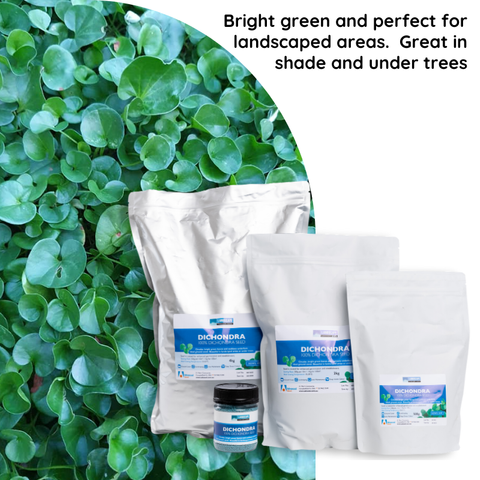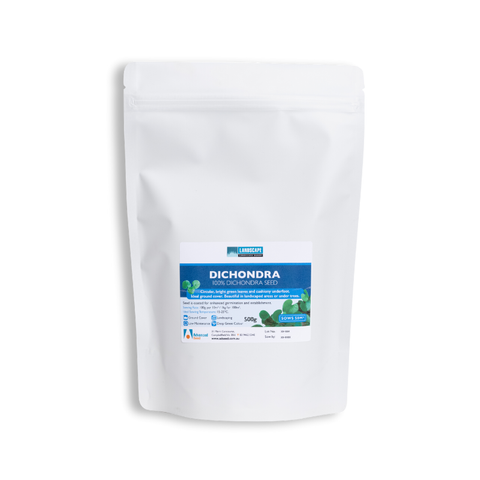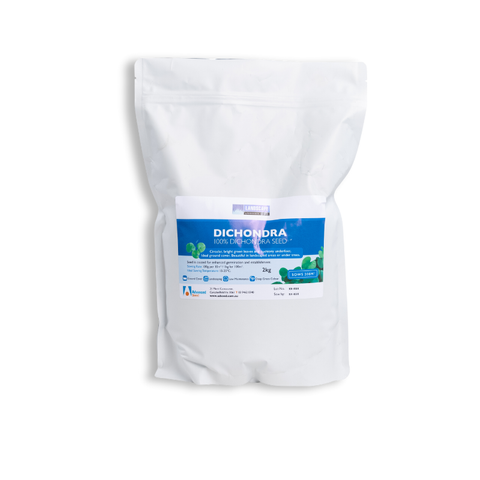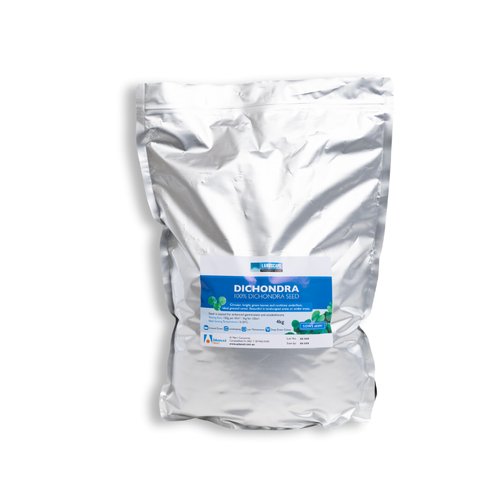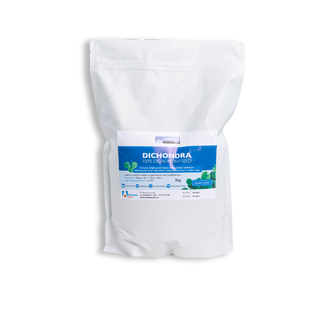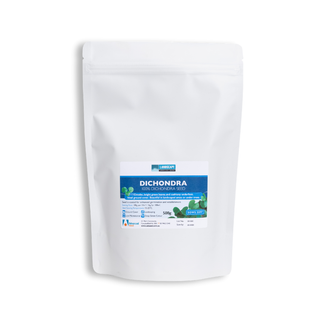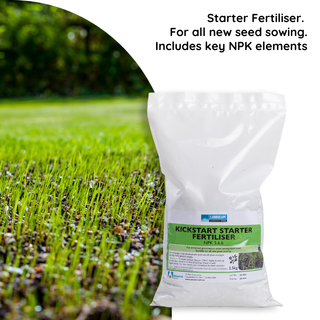Description
ADVANCED SEED DICHONDRA
100% Dichondra: “A beautiful lawn alternative or garden bed plant that grows well in Australia.”
Great Aussie Lawns top seller! Dichondra has very green, circular leaves and looks beautiful in landscaped areas where it does not need to be mowed. It does very well in shady areas where many grasses may not do well, e.g. under trees. It germinates well in Spring and Autumn and has a cushion feel underfoot. It can be used very successfully in areas that don’t get a lot of foot traffic.
SIZE 200g, 500g, 2kg, 4kg. Coated Seed
What is Dichondra?
Dichondra is often referred to as ‘Kidney Weed’ because it’s leaf is a similar shape. It grows across the surface area and creates a pretty trail of plant. It can be used as an alternative to lawn and can be walked on but is best suited to areas with low levels of traffic.
Key Features:
- 100% Dichondra Seed: Excellent Germination Rates
- Low maintenance: Does not need to be mowed.
- Versatile Uses: Ideal for homes gardens, and landscape areas
- Beneficial Coating: Ensures better germination and establishment.

"This product is fantastic! The first small tub I bought to do a test patch and I was very happy with the results. Just bought the 6th small tub to fill in some gaps this spring". Laura, Melbourne, Victoria.
Key Characteristics:
- Frost Tolerance: Very Good
- Shade Tolerance: Excellent
- Establishment Rate: Good (at optimum sowing time)
- Lateral Spread: Very good
- Drought Tolerance: Reasonable
- Heat Tolerance: Good
- Wear Tolerance: Low
Ideal Sowing Times:
- Northern NSW, Queensland, Northern WA: Early Spring/Autumn/Winter
- NSW / Western Australia / South Australia / Victoria / Tasmania: Spring / Autumn
- FNQ/NT: Spring/Autumn/Winter
Quality Rating: Premium Surface

Sowing Rate:
New Sowing: 1kg per 100m².

Sowing, Establishment & Maintenance Tips:
- Optimum Soil Type: Sandy Loam. Ask your local soil supplier for a good quality lawn soil mix.
- Starter Fertiliser: Use KickStart Starter Fertiliser to ensure successful germination.
- Sowing: Follow our Sowing Instructions for best results.
- Watering: For the first 30 days after seeding watering may be necessary 3-4 times a day. For best results seed bed should not be allowed to dry out.
- Watering Requirements: We recommend watering Dichondra deeply at least 2-3 times a week in summer or when there is no rainfall.
- Germination Time: In Optimal Conditions you may see germination in 10-14 days. Note: When sowing out of season this can take longer.
- Establishment: Allow 2 months for establishment before the onset of Autumn in Southern States or before any significantly cooler weather in your location.
- Regular Fertilising: Follow our Fertilising Instructions to ensure your lawn stays healthy throughout the seasons including Autumn and Spring fertilising.
Dichondra FAQ:
- How does Dichondra handle Shade?
Dichondra is very well suited to shade and is perfect for sowing under trees or in garden beds around other plants.
- How does Dichondra handle full Sun?
Dichondra is hardy and versatile but Australian Summers are challenging. Deep watering a few times a week will benefit. Similar to lawns, if you get patches seasonally or a very hot summer you can oversow at the end of the season to fill in.
- How does Dichondra handle cold winters and frost?
Dichondra copes very well with cold winters and frost. If you notice any patches appearing during the colder seasons, you can oversow to fill in areas.
- How much watering does is require?
Like all growing plants it needs irrigation in extended dry periods. It requires regular watering in dry months and extra irrigation in Summer (deep watering at least 2 x a week), but overall it is a hardy, versatile plant.
- Will it handle kids and pets?
Dichondra is better in low-traffic areas like garden beds and isn’t suited for surfaces that active dogs and kids will be playing on.
- How do I sow Dichondra seed?
Follow the same steps as in our Lawn Sowing Instructions. Use a Starter Fertiliser and keep the area continually damp during the germination phase... usually around 4 weeks.
- Will this grow in Perth/Canberra/NT/Brisbane?
Dichondra will grow in most Australian locations. See our ‘Can I Sow This’ section for your location and suitability.


ADVANCED SEED DICHONDRA
100% Dichondra: “A beautiful lawn alternative or garden bed plant that grows well in Australia.”
Great Aussie Lawns top seller! Dichondra has very green, circular leaves and looks beautiful in landscaped areas where it does not need to be mowed. It does very well in shady areas where many grasses may not do well, e.g. under trees. It germinates well in Spring and Autumn and has a cushion feel underfoot. It can be used very successfully in areas that don’t get a lot of foot traffic.
SIZE 200g, 500g, 2kg, 4kg. Coated Seed
What is Dichondra?
Dichondra is often referred to as ‘Kidney Weed’ because it’s leaf is a similar shape. It grows across the surface area and creates a pretty trail of plant. It can be used as an alternative to lawn and can be walked on but is best suited to areas with low levels of traffic.
Key Features:
- 100% Dichondra Seed: Excellent Germination Rates
- Low maintenance: Does not need to be mowed.
- Versatile Uses: Ideal for homes gardens, and landscape areas
- Beneficial Coating: Ensures better germination and establishment.

"This product is fantastic! The first small tub I bought to do a test patch and I was very happy with the results. Just bought the 6th small tub to fill in some gaps this spring". Laura, Melbourne, Victoria.
Key Characteristics:
- Frost Tolerance: Very Good
- Shade Tolerance: Excellent
- Establishment Rate: Good (at optimum sowing time)
- Lateral Spread: Very good
- Drought Tolerance: Reasonable
- Heat Tolerance: Good
- Wear Tolerance: Low
Ideal Sowing Times:
- Northern NSW, Queensland, Northern WA: Early Spring/Autumn/Winter
- NSW/Western Australia/South Australia/Victoria/Tasmania: Spring/Early Autumn
- FNQ/NT: Spring/Autumn/Winter
Quality Rating: Premium Surface

Sowing Rate:
New Sowing: 1kg per 100m².

Sowing, Establishment & Maintenance Tips:
- Optimum Soil Type: Sandy Loam. Ask your local soil supplier for a good quality lawn soil mix.
- Starter Fertiliser: Use KickStart Starter Fertiliser to ensure successful germination.
- Sowing: Follow our Sowing Instructions for best results.
- Watering: For the first 30 days after seeding watering may be necessary 3-4 times a day. For best results seed bed should not be allowed to dry out.
- Watering Requirements: We recommend watering Dichondra deeply at least 2-3 times a week in summer or when there is no rainfall.
- Germination Time: In Optimal Conditions you may see germination in 10-14 days. Note: When sowing out of season this can take longer.
- Establishment: Allow 2 months for establishment before the onset of Autumn in Southern States or before any significantly cooler weather in your location.
- Regular Fertilising: Follow our Fertilising Instructions to ensure your lawn stays healthy throughout the seasons including Autumn and Spring fertilising.
Dichondra FAQ:
- How does Dichondra handle Shade?
Dichondra is very well suited to shade and is perfect for sowing under trees or in garden beds around other plants.
- How does Dichondra handle full Sun?
Dichondra is hardy and versatile but Australian Summers are challenging. Deep watering a few times a week will benefit. Similar to lawns, if you get patches seasonally or a very hot summer you can oversow at the end of the season to fill in.
- How does Dichondra handle cold winters and frost?
Dichondra copes very well with cold winters and frost. If you notice any patches appearing during the colder seasons, you can oversow to fill in areas.
- How much watering does is require?
Like all growing plants it needs irrigation in extended dry periods. It requires regular watering in dry months and extra irrigation in Summer (deep watering at least 2 x a week), but overall it is a hardy, versatile plant.
- Will it handle kids and pets?
Dichondra is better in low-traffic areas like garden beds and isn’t suited for surfaces that active dogs and kids will be playing on.
- How do I sow Dichondra seed?
Follow the same steps as in our Lawn Sowing Instructions. Use a Starter Fertiliser and keep the area continually damp during the germination phase... usually around 4 weeks.
- Will this grow in Perth/Canberra/NT/Brisbane?
Dichondra will grow in most Australian locations. See our ‘Can I Sow This’ section for your location and suitability.


ADVANCED SEED DICHONDRA
100% Dichondra: “A beautiful lawn alternative or garden bed plant that grows well in Australia.”
Great Aussie Lawns top seller! Dichondra has very green, circular leaves and looks beautiful in landscaped areas where it does not need to be mowed. It does very well in shady areas where many grasses may not do well, e.g. under trees. It germinates well in Spring and Autumn and has a cushion feel underfoot. It can be used very successfully in areas that don’t get a lot of foot traffic.
SIZE 200g, 500g, 2kg, 4kg. Coated Seed
What is Dichondra?
Dichondra is often referred to as ‘Kidney Weed’ because it’s leaf is a similar shape. It grows across the surface area and creates a pretty trail of plant. It can be used as an alternative to lawn and can be walked on but is best suited to areas with low levels of traffic.
Key Features:
- 100% Dichondra Seed: Excellent Germination Rates
- Low maintenance: Does not need to be mowed.
- Versatile Uses: Ideal for homes gardens, and landscape areas
- Beneficial Coating: Ensures better germination and establishment.

"This product is fantastic! The first small tub I bought to do a test patch and I was very happy with the results. Just bought the 6th small tub to fill in some gaps this spring". Laura, Melbourne, Victoria.
Key Characteristics:
- Frost Tolerance: Very Good
- Shade Tolerance: Excellent
- Establishment Rate: Good (at optimum sowing time)
- Lateral Spread: Very good
- Drought Tolerance: Reasonable
- Heat Tolerance: Good
- Wear Tolerance: Low
Ideal Sowing Times:
- Northern NSW, Queensland, Northern WA: Early Spring/Autumn/Winter
- NSW/Western Australia/South Australia/Victoria/Tasmania: Spring/Early Autumn
- FNQ/NT: Spring/Autumn/Winter
Quality Rating: Premium Surface

Sowing Rate:
New Sowing: 1kg per 100m².

Sowing, Establishment & Maintenance Tips:
- Optimum Soil Type: Sandy Loam. Ask your local soil supplier for a good quality lawn soil mix.
- Starter Fertiliser: Use KickStart Starter Fertiliser to ensure successful germination.
- Sowing: Follow our Sowing Instructions for best results.
- Watering: For the first 30 days after seeding watering may be necessary 3-4 times a day. For best results seed bed should not be allowed to dry out.
- Watering Requirements: We recommend watering Dichondra deeply at least 2-3 times a week in summer or when there is no rainfall.
- Germination Time: In Optimal Conditions you may see germination in 10-14 days. Note: When sowing out of season this can take longer.
- Establishment: Allow 2 months for establishment before the onset of Autumn in Southern States or before any significantly cooler weather in your location.
- Regular Fertilising: Follow our Fertilising Instructions to ensure your lawn stays healthy throughout the seasons including Autumn and Spring fertilising.
Dichondra FAQ:
- How does Dichondra handle Shade?
Dichondra is very well suited to shade and is perfect for sowing under trees or in garden beds around other plants.
- How does Dichondra handle full Sun?
Dichondra is hardy and versatile but Australian Summers are challenging. Deep watering a few times a week will benefit. Similar to lawns, if you get patches seasonally or a very hot summer you can oversow at the end of the season to fill in.
- How does Dichondra handle cold winters and frost?
Dichondra copes very well with cold winters and frost. If you notice any patches appearing during the colder seasons, you can oversow to fill in areas.
- How much watering does is require?
Like all growing plants it needs irrigation in extended dry periods. It requires regular watering in dry months and extra irrigation in Summer (deep watering at least 2 x a week), but overall it is a hardy, versatile plant.
- Will it handle kids and pets?
Dichondra is better in low-traffic areas like garden beds and isn’t suited for surfaces that active dogs and kids will be playing on.
- How do I sow Dichondra seed?
Follow the same steps as in our Lawn Sowing Instructions. Use a Starter Fertiliser and keep the area continually damp during the germination phase... usually around 4 weeks.
- Will this grow in Perth/Canberra/NT/Brisbane?
Dichondra will grow in most Australian locations. See our ‘Can I Sow This’ section for your location and suitability.


ADVANCED SEED DICHONDRA
100% Dichondra: “A beautiful lawn alternative or garden bed plant that grows well in Australia.”
Great Aussie Lawns top seller! Dichondra has very green, circular leaves and looks beautiful in landscaped areas where it does not need to be mowed. It does very well in shady areas where many grasses may not do well, e.g. under trees. It germinates well in Spring and Autumn and has a cushion feel underfoot. It can be used very successfully in areas that don’t get a lot of foot traffic.
SIZE 200g, 500g, 2kg, 4kg. Coated Seed
What is Dichondra?
Dichondra is often referred to as ‘Kidney Weed’ because it’s leaf is a similar shape. It grows across the surface area and creates a pretty trail of plant. It can be used as an alternative to lawn and can be walked on but is best suited to areas with low levels of traffic.
Key Features:
- 100% Dichondra Seed: Excellent Germination Rates
- Low maintenance: Does not need to be mowed.
- Versatile Uses: Ideal for homes gardens, and landscape areas
- Beneficial Coating: Ensures better germination and establishment.

"This product is fantastic! The first small tub I bought to do a test patch and I was very happy with the results. Just bought the 6th small tub to fill in some gaps this spring". Laura, Melbourne, Victoria.
Key Characteristics:
- Frost Tolerance: Very Good
- Shade Tolerance: Excellent
- Establishment Rate: Good (at optimum sowing time)
- Lateral Spread: Very good
- Drought Tolerance: Reasonable
- Heat Tolerance: Good
- Wear Tolerance: Low
Ideal Sowing Times:
- Northern NSW, Queensland, Northern WA: Early Spring/Autumn/Winter
- NSW/Western Australia/South Australia/Victoria/Tasmania: Spring/Early Autumn
- FNQ/NT: Spring/Autumn/Winter
Quality Rating: Premium Surface

Sowing Rate:
New Sowing: 1kg per 100m².

Sowing, Establishment & Maintenance Tips:
- Optimum Soil Type: Sandy Loam. Ask your local soil supplier for a good quality lawn soil mix.
- Starter Fertiliser: Use KickStart Starter Fertiliser to ensure successful germination.
- Sowing: Follow our Sowing Instructions for best results.
- Watering: For the first 30 days after seeding watering may be necessary 3-4 times a day. For best results seed bed should not be allowed to dry out.
- Watering Requirements: We recommend watering Dichondra deeply at least 2-3 times a week in summer or when there is no rainfall.
- Germination Time: In Optimal Conditions you may see germination in 10-14 days. Note: When sowing out of season this can take longer.
- Establishment: Allow 2 months for establishment before the onset of Autumn in Southern States or before any significantly cooler weather in your location.
- Regular Fertilising: Follow our Fertilising Instructions to ensure your lawn stays healthy throughout the seasons including Autumn and Spring fertilising.
Dichondra FAQ:
- How does Dichondra handle Shade?
Dichondra is very well suited to shade and is perfect for sowing under trees or in garden beds around other plants.
- How does Dichondra handle full Sun?
Dichondra is hardy and versatile but Australian Summers are challenging. Deep watering a few times a week will benefit. Similar to lawns, if you get patches seasonally or a very hot summer you can oversow at the end of the season to fill in.
- How does Dichondra handle cold winters and frost?
Dichondra copes very well with cold winters and frost. If you notice any patches appearing during the colder seasons, you can oversow to fill in areas.
- How much watering does is require?
Like all growing plants it needs irrigation in extended dry periods. It requires regular watering in dry months and extra irrigation in Summer (deep watering at least 2 x a week), but overall it is a hardy, versatile plant.
- Will it handle kids and pets?
Dichondra is better in low-traffic areas like garden beds and isn’t suited for surfaces that active dogs and kids will be playing on.
- How do I sow Dichondra seed?
Follow the same steps as in our Lawn Sowing Instructions. Use a Starter Fertiliser and keep the area continually damp during the germination phase... usually around 4 weeks.
- Will this grow in Perth/Canberra/NT/Brisbane?
Dichondra will grow in most Australian locations. See our ‘Can I Sow This’ section for your location and suitability.



![]()





